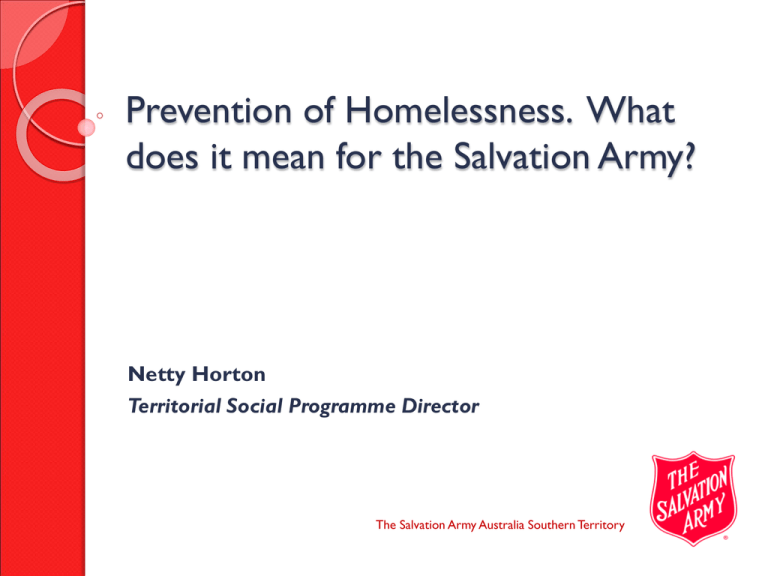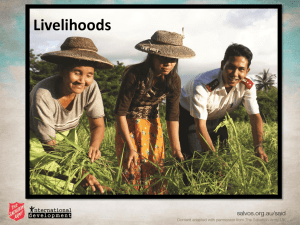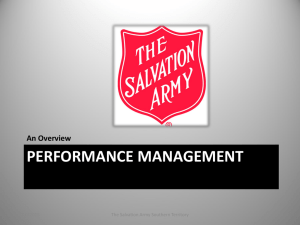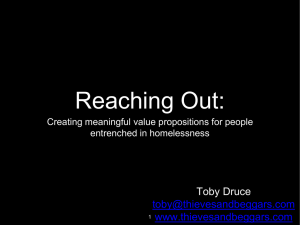Netty Horton Territorial Social Programme Director
advertisement

Prevention of Homelessness. What does it mean for the Salvation Army? Netty Horton Territorial Social Programme Director The Salvation Army Australia Southern Territory Salvation Army Social Programmes Southern Territory 600 social programmes including emergency relief, housing and homelessness, drug and alcohol, children and family services $300 million Every night providing 600 crisis and 4,000 non crisis beds and over 80,000 meals The Salvation Army Australia Southern Territory Homelessness Prevention Often used term Prevention vs early intervention vs crisis response Saving $ Saving costly impact on lives of individuals and families The Salvation Army Australia Southern Territory Government White Paper 2008 – “The Road Home” “Turning off the Tap” – A Focus on Prevention Prevention and early intervention are the most effective and efficient ways to reduce homelessness. Prevention strategies need to be given a greater focus in the future homelessness response. Prevention strategies should be focused on key transition points and life events. There are many examples of successful prevention strategies at the local level. Over the next 10 years, effort should be focused on delivering evidence-based prevention at scale across the country. Specific responses are required for different cohorts. The Salvation Army Australia Southern Territory Turning off the Tap Initiatives Initiatives under this strategy include: Increasing support for people in public and private rental housing to maintain their tenancies (HA 8/10) Assisting up to 9,000 additional young people between 12 and 18 years of age to remain connected with their families (HA 6/10) Assisting up to 2,250 additional families at risk of homelessness to stay housed (HA 10/10) ‘No exits into homelessness’ from statutory, custodial care, health, mental health and drug and alcohol services (HA /10) Helping women and children who experience domestic violence to stay safely in the family Home (HA 5/10) Delivering community based mental health services under the Personal Helpers and Mentors Program (PHAMs) to 1,000 difficult to reach Australians, including people who are homeless (HA 7/10) Establishing a network of 90 Community Engagement Officers to improve access to Centrelink services for people at risk of homelessness. (HA 9/10) The Salvation Army Australia Southern Territory Victorian Homelessness Action Plan The Government, through the Victorian Homelessness Action Plan, will: support innovative approaches to homelessness investigate models that focus specifically on early intervention and prevention better target resources when and where they are most needed and where they will make the biggest difference. We will build a service system that meets a range of needs where people are able to access help, advice and assistance where and when they need it. The Salvation Army Australia Southern Territory Key Issues Causes of homelessness are structural and should be addressed as part of a partnership approach between and across Governments, and between and across service providers. National Partnership Agreement on Homelessness– Existing and Future The Salvation Army Australia Southern Territory Key Issues continued Difference between early intervention and prevention and does it matter? Yes And No! The Salvation Army Australia Southern Territory What does TSA do already? Prevention (little) Early Intervention (some) Crisis (most) The Salvation Army Australia Southern Territory The Economic Social Impact Survey What people did and felt in response to their financial situations. Felt stressed about the future? 71% Cut down on luxuries? 68% Asked for help from a welfare or community organisation.? 66% Delayed or been unable to pay electricity, gas or telephone bill/s on time? 59% Cut down on basic necessities? 59% Asked for financial help from friends or family? 56% Gone without meals? 52% Needed to sell or pawn possessions? 45% Experienced new conflict with your family? 35% Delayed or been unable to pay rent or mortgage on time? 35% Taken on new debt (loans, credit cards etc)? 25% Moved to more affordable housing? 21% Attempted to supplement income by gambling (e.g. pokies)? Done nothing different? 9% 3% The Salvation Army Australia Southern Territory “I have never struggled this much before.” “There are times I think I am better off not alive.” “Thought about selling my stuff, but there is not much to sell. I’m poor.” “Everything is so expensive now – I feel helpless.” “Feel like I have hit lowest point and no one is there to help.” “I’m trying so hard not to be in this position – it makes me cry some nights.” “The rising cost of living and no change in income makes living week to week (let alone day to day) and feeding my family very difficult.” The Salvation Army Australia Southern Territory Findings 2 The essentials of life – what I don’t have. Up to $500 in savings for an emergency 94% A weeks holdiday away from home each year 89% Home contents insurance 87% Comprehensive Motor Vehicle Insurance 73% A hobby or leisure (out of school) activity for children 58% Dental Treatment if required 57% Presents for family or friends at least once a year 51% Up to date schoolbooks and new school clothers 43% A yearly dental check up for children 42% Computer skills 42% A separate bedroom for each child over 10 41% Regular social contact with other people 37% Able to buy medicines prescribed by a doctor 37% Children can participate in school activities and outlings Roof and gutters that don't leak Secure locks on doors and windows Heating in at least one room 36% 35% 34% 33% The Salvation Army Australia Southern Territory Findings 3 Multiple deprivations 11 or more indicators 36% 5-10 indicators 50% 4 indicators 3 indicators 2 indicators 1 indicator 5% 4% 3% 2% Saunders et al (2007) note that severe levels of deprivation correspond to missing our on at least 5 or more area simultaneously The Salvation Army Australia Southern Territory Prevention Advocacy Big Picture, income, affordable housing, education, community building Implications: Diverting Mission Support Funding The Salvation Army Australia Southern Territory Conclusions Homelessness appears as TSA’s “core business.” Prevention is our ultimate goal Should prevention be our service goal, or is it one of many? The Salvation Army Australia Southern Territory








